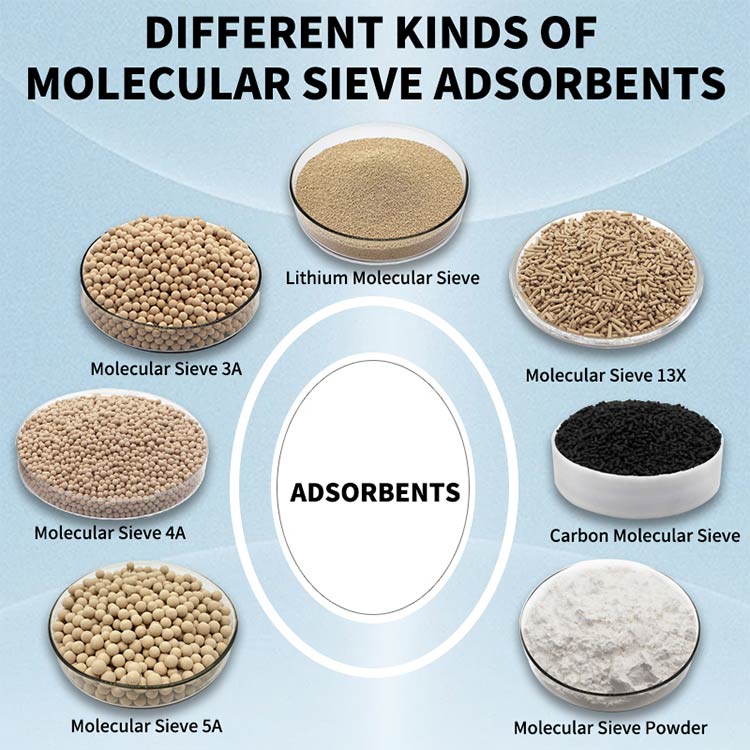

Adsorbent Index
There are many types of adsorbents, which can be classified according to chemical composition, shape, size, specific surface area and other characteristics. Each adsorbent can be further subdivided according to different models and functions. According to incomplete statistics, if artificial synthesis and modified materials are included, the models of adsorbents can reach up to 100,000.
In order to meet more diversified working conditions and achieve more efficient and accurate adsorption, the screening and matching of adsorbents have become important issues in the compressed air drying process.
For the adsorbents commonly used in air dryers, their water adsorption capacity, crushing strength, abrasion ratio and bulk density are the most critical technical indicators.
Water Adsorption Capacity
Water adsorption refers to the value of water adsorbed by the adsorbent. It can be divided into static adsorption and dynamic adsorption. The most important in the application of compressed air dryers is dynamic water adsorption. The higher this value is, the stronger its adsorption performance is, and the better the quality of the finished gas obtained under standard working conditions.
The dew point of compressed air actually represents the water content of compressed air, and it is also one of the important measurement criteria for judging whether the quality of compressed air meets the standard. The dew point of air with high water content is high, and the dew point of air with low water content is low.
If the water content of compressed air is high, it may cause corrosion or ice blockage of the machine, and the quality of compressed air cannot meet the use standard. Therefore, generally speaking, we hope that the pressure dew point is as low as possible, that is, we expect the water adsorption of the adsorbent to be as high as possible.
Theoretically, when the working conditions are good, the pressure dew point of compressed air can reach -50℃ by using activated alumina as a desiccant, while the pressure dew point can reach -70℃ by using molecular sieve drying. The drying capacity of microporous zeolite molecular sieve is generally much stronger than that of activated alumina, but the cost is higher and the life span is lower than that of activated alumina. Therefore, before choosing which adsorbent to use, it is necessary to clarify the expected value of the water adsorption of the adsorbent and the dew point requirements of the equipment.
The compressive strength of adsorbent particles refers to the maximum pressure that a single adsorbent particle can withstand on average. Because the adsorbent will be subjected to higher pressure in the adsorption tower, it is required to have higher compressive strength.
For adsorbents of the same composition, the larger the particle size, the higher the compressive strength. The adsorbent of the appropriate size should be selected according to the actual application needs.
Wear Ratio
The degree of wear of the adsorbent when it is impacted by external force or collides with each other is often characterized by the wear rate. Under normal working conditions, the smaller the wear rate of the adsorbent in the adsorption tower, the less dust is generated during operation.
The industry requires that the wear rate of activated alumina is less than 3% and the wear rate of molecular sieve is less than 1%. If the wear rate is high, it is easy to generate excessive dust, which is easy to cause the back-end filter to be blocked and also affect the quality of the finished gas.
Generally speaking, it is inevitable for adsorbents to generate dust, but Xintao Technology has greatly reduced the wear rate of products through continuous upgrading of product production processes and optimization of processes over the years.
Bulk Density
Bulk density refers to the mass per unit volume of bulk material in a stacked state. Bulk density will affect the loading amount of the adsorbent. For example, it is expected that 720 kilograms of activated alumina can be filled in a volume of 1 cubic meter, that is, the bulk density of activated alumina is 720 kg/m³. The particle size and component content of the adsorbent will affect its bulk density.
In practical applications, we need to fully combine the actual working conditions and specific adsorption indicators to select the best solution that can meet the performance requirements and reduce the cost of use.
If you are interested in our absorbents, please do not hesitate to send us your inquiry to info@xintaokeji.com.